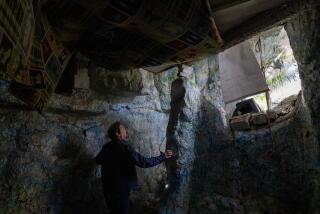Roaming the open spaces of Santa Barbara
— A creeks cuts out of the Santa Ynez Mountains about 25 miles west of Santa Barbara. It follows a tight canyon from grass-covered foothills to the sea, passing an old adobe underneath a giant eucalyptus and grapevines planted when California was part of Mexico. There’s the smell of sage. Deep quiet. Wind in the leaves.
This is the Arroyo Hondo Preserve, known as “the jewel of the Gaviota Coast.” I don’t know about that. The whole western skirt of the mountains, draping down to the ocean between Goleta and Point Conception, is mostly undeveloped God’s country. But even there, Arroyo Hondo is special, a patch of paradise that has evaded the rush to build and people the Golden State, not to mention a government that has turned similar pristine parcels along the Gaviota coast into parks, a sometimes dubious form of conservation that brings all that public access entails.
Arroyo Hondo exists because a decade ago, when its owners were on the verge of selling, it was bought by the Land Trust for Santa Barbara County, a private organization that has helped preserve 22,000 acres of open space, including bluffs and a salt marsh in Carpinteria, a butterfly preserve in Goleta and the old Sedgwick Ranch in the Santa Ynez Valley.
Like Arroyo Hondo, many of the preserves are open to the public (sometimes by reservation only) because giving people the chance to experience them is part of the trust’s mission.
But only a part. In other fascinating cases the organization has assisted landowners — especially farmers and ranchers — with keeping their properties intact and devoted to agriculture through the sale of conservation easements that restrict certain types of development by mutual agreement between the seller and the trust.
Forever attached to the deed, easements tend to erode a property’s market value; on the other hand, they are a way for farmers and ranchers to generate cash they might otherwise have to raise by putting the back 40 on the block. The land remains private, off-limits to hikers, campers and sightseers; that’s the downside to populists like me. The upside has to do with something broader: preserving big sweeps of landscape such as the glorious Gaviota Coast for anyone to see who drives along U.S. 101.
“A lot of damage has already been done,” said Land Trust Executive Director Michael Feeney. “Farmlands like the orange groves of Irvine are gone.”
Walking through Arroyo Hondo in April with Feeney, I wondered about the Ortega family, who received the canyon in 1827 as part of a grant from the Mexican government. The two-room adobe they built in 1842 was a stagecoach stop, the site of a schoolhouse for Gaviota Coast children and a hide-out for desperadoes.
Feeney showed me educational displays in the barn where local students learn about plants, animals and the canyon’s Native American history. Then we followed a path along the creek (one of several trails open to hikers and picnickers two weekends a month) to a meadow where the Land Trust holds Father’s Day camp-outs, music and barbecue included. The old adobe serves as a visitors center with vintage photos of Arroyo Hondo and its people.
Feeney’s organization has just four full-time staff members, and every time a critical property goes up for sale he and his colleagues must compete with developers by raising funds for the purchase through grants and donations. Carpinteria Bluffs, a stunning 52-acre postage stamp of California coast looking south to the Channel Islands, is a case in point. For 20 years locals fought a battle over its fate, ultimately seeking help from the trust, which persuaded the owner to sell for $3.9 million. The hitch was that the money had to be raised in four months.
A sign at the entrance to Carpinteria Bluffs testifies to the trust’s success. It says, “This land is preserved forever.”
When I walked there in the spring a storm the previous day had left the air fresh, views toward Anacapa Island sharp, the surf lashing the beach rough. I’d taken barely 20 steps before I saw a blue heron stalking through the grass like some proto-bird from the age of the dinosaur.
There were hummingbirds in a eucalyptus allée and monarch butterflies floating over the train tracks that separate the preserve from the beach, a breeding place for harbor seals. People with earbuds and dogs roamed freely too, and kids with mitts were taking positions on the adjoining ball fields added when the trust, which manages only a few of the properties it conserves, gave it to the city of Carpinteria.
Visiting the bluffs raises questions such as who should preserve such places. Private entities or the state? I was going round and round on that one until I saw the Coronado Butterfly Preserve, another Land Trust property near the coast in Goleta. It covers a scant 10 acres but served as a toehold for conservation of a prime monarch butterfly roosting place, city-owned Ellwood Mesa.
Last winter was big for migrating monarchs, with 40,000 counted on the mesa. By the time I got here only a few stragglers were left. But the preserve, which sits at the dead end of an ordinary suburban street, had been colonized by neighborhood children, hallooing in the trees and popping wheelies on their bikes.
That made me remember something Feeney said: “When I was a kid there used to be woods. Where do they go now?”
Evidently to the butterfly preserve and other precious open spaces. Long may they be preserved.
More to Read
Sign up for The Wild
We’ll help you find the best places to hike, bike and run, as well as the perfect silent spots for meditation and yoga.
You may occasionally receive promotional content from the Los Angeles Times.






